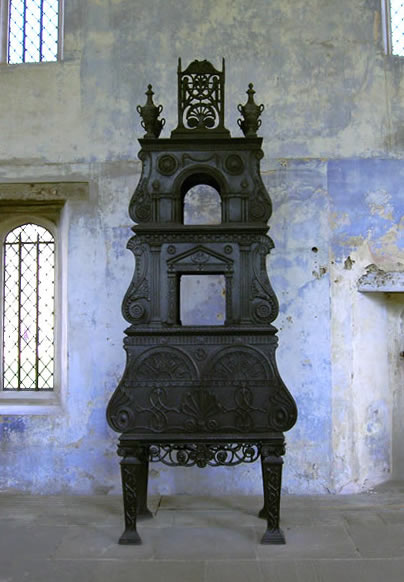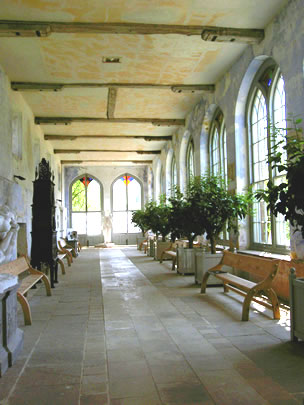Helen has long been interested in the history of orangeries, and so was delighted to act as one of the advisers on the re-instatement of the orangery at Knole Park in late 2009/early 2010. The position brought unexpected archival dividends for her research into historic orangeries, and prompted further research using the sketch books and diaries of Sir George Scharf as a manuscript source. This article gives a first outline of some of her findings.

Figure 1. The Buzalgo[ref]The Buzalgo stove is a rare survivor of an 18th century heater invented by Abraham Buzalgo (d.1788). An online article ‘Hot Air from Cambridge Library’ notes that in 1744 there were eleven models in production in various sizes. Knole’s may be one of the only two surviving stoves on public display (the other said to be at Williamsburg, Virginia, in the United States.[/ref]
Acting as one of the advisers on the re-instatement of the orangery at Knole Park in late 2009/early 2010 brought unexpected archival dividends for my research into historic orangeries. Standing in the then empty orangery, marvelling at the amazing stove (later identified as a Buzaglo – see FIG. 1) and watching the play of the wintry light through the huge windows with their coloured glass insets, sparked a wish to return to the topic at some future date. In the autumn of 2011 the opportunity arose. With the Sackville papers temporarily unavailable while the Centre for Kentish Archives relocated to their new site, the focus of my research switched to the National Portrait Gallery Heinz Archive & Library and the papers of the Gallery’s first director, Sir George Scharf (1820-95).
Scharf was a man with a mission. Appointed Secretary to the newly-established gallery in 1857 then, from 1882, Director, he was charged with the task of collecting portraits for the new gallery. He visited many of the key historic houses of the era to make an inventory of portraits (including engravings) in private hands, as well as in public collections. The findings would also help the gallery distinguish copies, and identify the best methods of capturing images. With photography still in its infancy his sketchbooks are the pictorial record of his visits, a nineteenth century precursor to the notion of an image bank.
The sketch books suggest Scharf first visited Knole in 1858.Over the next four decades, he became a regular visitor; in later years often staying as a guest. From 1877 Knole is mentioned in his diaries. Scharf visited it more than any of the other houses on his itinerary; his diaries and sketchbooks are windows into life there during the years 1858 to 1891, as well as a record of the art on display.
The diaries do not mention the orangery which disappointed hopes of using them to update and extend earlier research. But the volumes are full of other interesting detail, including references to favourite routes for after dinner walks such as the hop garden, the kitchen garden, and the square flower garden.
The sketch books and volume of catalogues and lists are illuminating. Exquisite in their own right; Scharf’s miniaturist’s training evident in the sketches of paintings, rooms and exteriors, they are key documentary sources. Sir George’s sketch, made in 1867[ref]FIG 2 was temporarily licenced from the National Portrait Gallery, London, and showed a Sketch of the east facade of the Orangery at Knole by George Scharf’. Please contact the NPG to view, Ref. NPG 7/3/4/2/78 pp 40-1[/ref] from a framed sepia-tinted architectural drawing in the ballroom, is not just delightful. For here we may have an image of how the orangery, to the left, faced across the east garden to a pedimented conservatory and adjoining greenhouse close by the chapel. Scharf ‘s sketch may be a rare pictorial clue to the exterior shape of the conservatory at an earlier date, and the sequence of a succession of glasshouses by the chapel – including the camellia house posited by Kristina Taylor in her 2001 research [ref]Kristina Taylor ,‘The Park and Gardens at Knole. Conservation issues.Copy of Architectural Association dissertation, 2001.National Trust files, Scotney Castle, Area Office files. The files are a very useful documentary sources especially the historical section in the 2009 Conservation Management Plan by Historic Landscape Management Ltd., Lyng, Norfolk; notes by Jane Brightwell, Centre for Conservation Historic Parks and gardens, n.d. and a photocopy taken from the 1865 photograph described as side view of glass house attached to conservatory.[/ref] but as it is a drawing made from another’s record confirmation awaits further research. A copy of a photographs taken in 1865 and now in the National Trust files shows a single, un-pedimented roofline for a glasshouse and conservatory.
This same Scharf sketchbook also contains a plan of the ground floor rooms[ref]FIG 3 was temporarily licenced from the National Portrait Gallery, London, and showed a Rough sketch of the ground floor plan of the Orangery at Knole by George Scharf’. Please contact the NPG to view, Ref. NPG 7/3/4/2/78 p 40 SSB67[/ref]. Together with the foldout plan in a volume of catalogues and lists, 1881 [ref]NPG 7/1/3/3/1/3 p 221 (currently non-digitised image). Another copy of the floorplan is currently held on deposit by the National Trust from Lord Sackville.[/ref] these three illustrations not only provide a snapshot of the orangery in relation to the glasshouses, they encapsulate the history of orangeries as the concept morphed into the nineteenth century’s glasshouses and conservatories, and describe how the adjoining rooms were configured. For example the room used as a Library by Lord Plymouth [ref]Arabella’s son, the 4th Duke of Dorset, died following a hunting accident in 1815. After her death Knole was occupied in succession by her daughters before it passing to Mortimer, 1st Lord Sackville (1820-88). Mary’s first husband, Lord Plymouth (d.1833) had a study next to the old conservatory. Mary’s second husband was Lord Amherst (d. 1857). The fold out plan describes the room abutting the old orangery as Lady Amherst (d. 1864)’s dressing room. Scharf appears to have visited Knole on four occasions during Mary’s ownership, another four during Elisabeth (Lady Buckhurst)’s. The highest number of visits (ten) were made during Mortimer, Lord and Lady Sackville’s time; and only once during Lord (Lionel) Sackville’s.[/ref] in the south east corner of the house opened into a conservatory. A juxtaposition popular since the 1830s when it has been recommended by J C Loudon (1783-1843) in his The Green house companion (1832).
But the grouping at Knole intrigues for another reason. Although part of the main house – it was originally used to accommodate Henry VIII’s entourage on his visits, the orangery, in its present configuration, is actually later than the conservatory it once faced which dates from the 3rd Duke of Dorset’s time and the fashion for cultivating pineapples.
The remodelling was commissioned in 1823-4 by Charles (later 1st Earl) Whitworth (1752-1825), a somewhat hapless, if high-ranking, British diplomat, and a former Lord Lieutenant of Ireland. Marriage to Arabella (d. 1825), widow of John Sackville, the 3rd Duke of Dorset (1745-99) brought him to Knole. Both he and the Duchess undertook major projects at other Sackville estates. Whitworth commissioned Humphry Repton (1752-1818) to advise on improving Buckhurst House in 1805.Later the Duchess amalgamated the two Buckland estates into one: Buckhurst Park and planned embellishments to the grounds in 1819.
Whitworth’s scheme for the orangery at Knole may well have been a re-instatement of the building’s eighteenth century role as ‘The green house’ before it had lapsed into use as the lumber room described by John Bridgman ( the steward at Knole) in An Historical and Topographical Sketch of Knole in Kent: with a Brief Genealogy of the Sackville family (1817). Whitworth’s plan saw the first floor removed but the attics retained; the small ground floor windows were replaced by much larger ones and full height double doors opened onto the lawn. Orangeries were sometimes used as sculpture galleries and this may well have been the case at Knole.
The documents consulted in my researches provided tantalizing glimpses into the history of the orangery at Knole and its place in the history of the house and garden. Only the original orangery survives but with the aid of documents in the NPG archive, National Trust files and the Kent Archives, it is possible to begin to conjure up a lost sequence of buildings and patterns of former use; a microcosm of the history of orangeries and their descendents which still has the power to beguile today.
Acknowledgements: National Portrait Gallery, National Trust.

